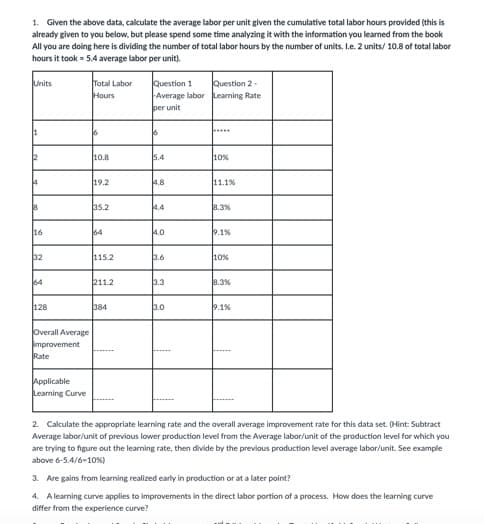Units Total Labor Hours Question 1 Average labor Learning Rate per unit Question 2- 10.8 5.4 10% 19.2 4.8 11.1% 35.2 4.4 8.3% 16 64 4.0 9.1% 32 115.2 3.6 10% 64 211.2 3.3 8.3% 128 384 3.0 9.1% Overall Average mprovement Rate Applicable Learning Curve 2 Calculate the appropriate learning rate and the overall average improvement rate for this data set. Jsbora
Units Total Labor Hours Question 1 Average labor Learning Rate per unit Question 2- 10.8 5.4 10% 19.2 4.8 11.1% 35.2 4.4 8.3% 16 64 4.0 9.1% 32 115.2 3.6 10% 64 211.2 3.3 8.3% 128 384 3.0 9.1% Overall Average mprovement Rate Applicable Learning Curve 2 Calculate the appropriate learning rate and the overall average improvement rate for this data set. Jsbora
Chapter9: Production Functions
Section: Chapter Questions
Problem 9.2P
Related questions
Question
2. Calculate the appropriate learning rate and the overall average improvement rate for this data set. (Hint: Subtract Average labor/unit of previous lower production level from the Average labor/unit of the production level for which you are trying to figure out the learning rate, then divide by the previous production level average labor/unit. See example above 6-5.4/6=10%)
I included an image that has a table in it

Transcribed Image Text:1. Given the above data, calculate the average labor per unit given the cumulative total labor hours provided (this is
already given to you below, but please spend some time analyzing it with the information you learned from the book
All you are doing here is dividing the number of total labor hours by the number of units. L.e. 2 units/ 10.8 of total labor
hours it took = 5.4 average labor per unit).
Total Labor
Hours
Question 1
Average labor Leaming Rate
Units
Question 2-
per unit
...
12
10.8
5.4
10%
4
19.2
4.8
11.1%
35.2
4.4
8.3%
16
64
4.0
9.1%
32
115.2
3.6
10%
64
211.2
3.3
8.3%
128
384
3.0
9.1%
Overall Average
improvement
Rate
Applicable
Learning Curve
2. Calculate the appropriate learning rate and the overall average improvement rate for this data set. (Hint: Subtract
Average labor/unit of previous lower production level from the Average labor/unit of the production level for which you
are trying to figure out the learning rate, then divide by the previous production level average labor/unit. See example
above 6-5.4/6-10%)
3. Are gains from learning realized early in production or at a later point?
4. A learning curve applies to improvements in the direct labor portion of a process. How does the learning curve
differ from the experience curve?
Expert Solution
This question has been solved!
Explore an expertly crafted, step-by-step solution for a thorough understanding of key concepts.
This is a popular solution!
Trending now
This is a popular solution!
Step by step
Solved in 2 steps with 2 images

Knowledge Booster
Learn more about
Need a deep-dive on the concept behind this application? Look no further. Learn more about this topic, economics and related others by exploring similar questions and additional content below.Recommended textbooks for you


Exploring Economics
Economics
ISBN:
9781544336329
Author:
Robert L. Sexton
Publisher:
SAGE Publications, Inc



Exploring Economics
Economics
ISBN:
9781544336329
Author:
Robert L. Sexton
Publisher:
SAGE Publications, Inc



Principles of Economics 2e
Economics
ISBN:
9781947172364
Author:
Steven A. Greenlaw; David Shapiro
Publisher:
OpenStax

Economics (MindTap Course List)
Economics
ISBN:
9781337617383
Author:
Roger A. Arnold
Publisher:
Cengage Learning